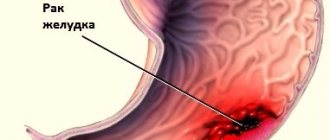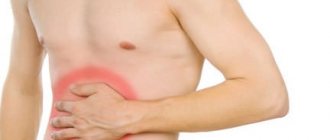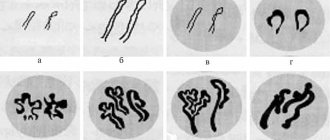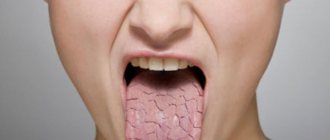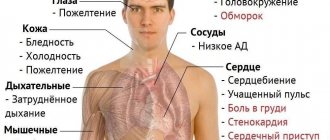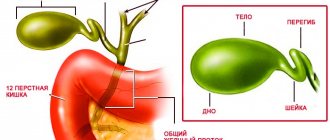Reasons and options
Spasm is the leading pathogenetic mechanism of constipation, when one part of the intestine is relaxed, and the other is compressed and does not allow feces to pass through. Areas of compression and relaxation alternate, active peristalsis is accompanied by pain, discomfort and an uncontrollable urge to go to the toilet.
Different from organic causes (tumor, stenosis), spasticity is most often a purely functional disorder due to:
- Dysfunction of the autonomic nervous system;
- Neuroses and stress (influence of the cortex);
- Violations of bowel movements;
- Diet disorders;
- Dysbacteriosis and acute intestinal infections;
- Uncontrolled use of laxatives;
- Taking neurotropic drugs.
Types of spastic constipation: cologenic (rumbling and flatulence, transfusion, colic in the lower abdomen and in the right iliac fossa due to hypotension or antiperistalsis), proctogenic (feeling of fullness and incomplete emptying in the rectum due to sphincter spasm, pelvic floor dysfunction or loss of reflex for defecation) and mixed.
Symptoms
- Retention of stool;
- Cramping or colicky pain in the abdomen;
- False and imperative (urgent) urge to defecate;
- Feeling of incomplete “cleansing”;
- Flatulence;
- Mucus in stool, “sheep feces”;
- Irregular bowel movements (alternating constipation and diarrhea);
- Irritability, fatigue, headache;
- Nausea, loss of appetite;
- Depression, neurosis.
The clearest example of spastic constipation is irritable bowel syndrome, in which, against the background of health and in the absence of gastroenterological diseases, spastic constipation is observed, the treatment of which is aimed at normalizing the balance in the autonomic nervous system.
The vagus nerve is primarily responsible for motility and secretion in the intestine; its activation against the background of reduced activity of the sympathoadrenal system leads to spastic constipation.
Diagnostics
To diagnose spastic constipation, a collection of complaints and anamnesis, an objective examination, instrumental and laboratory examination are carried out.
On palpation, pain is detected along the intestine. The relaxed cecum and the spasmodic sigmoid colon are well palpated, and sometimes fecal stones in the sigmoid colon.
The following instrumental methods are used:
- sigmoidoscopy (visual examination of the mucous membrane of the rectum and some parts of the sigmoid colon using a sigmoidoscope);
- irrigoscopy (x-ray examination of the large intestine with the introduction of a contrast agent into it);
- fibrocolonoscopy (endoscopic examination of the inner surface of the large intestine).
In some cases, an ultrasound examination of the stomach, pancreas, liver, and intestines is performed; plain radiography of the abdominal cavity, enterocolonoscintigraphy (with its help, intestinal motor function is assessed). Children with spastic constipation may require consultation with a neurologist with echoencephalography and electroencephalography.
Laboratory tests are prescribed: stool analysis for dysbiosis and helminth eggs, coprogram, general and biochemical blood test.
Differential diagnosis of spastic constipation is carried out with intestinal diseases with similar symptoms, including intestinal obstruction, which, in turn, can be a complication of acute myocardial infarction.
Treatment
Basically, treatment for spastic constipation is symptomatic and aimed at normalizing the balance in the autonomic nervous system:
- A gentle diet, fractional meals, refusal of gas-forming and strengthening foods;
- Antispasmodics (with caution to avoid atonic constipation) and prokinetics (normalize motility - dicetel and mebeverine);
- Neurotropic drugs (sedatives, anxiolytics with a pronounced autonomic effect such as phenazepam in short courses).
If the patient has spastic constipation, treatment may also include classical homeopathy and acupuncture as a systemic effect on the balance of the autonomic nerves. Typically, a course of ten to twelve procedures is quite enough for a lasting annual effect and relief of symptoms, improvement of overall tone and well-being.
Diagnostic measures
If symptoms of the atonic form of the disease appear, you need to go to the doctor. The specialist will prescribe tests that will confirm the disease. Then effective treatment will be selected. When there are obvious symptoms of atonic constipation, it is enough to answer the doctor some questions, take blood tests, stool tests, and undergo a digital examination.
When the clinical picture is blurred, atypical symptoms are present, differentiation from other diseases is needed, and additional diagnostic procedures are prescribed.
Research methods that may be required to confirm the diagnosis:
- rectoscopy - endoscopy to visualize the condition of the rectum and sigmoid region;
- colonoscopy - endoscopy to visualize all parts of the large intestine, with the exception of the rectum;
- irrigoscopy - x-ray using a contrast agent to study intestinal patency.
Additionally, you need to consult a urologist for men and a gynecologist for women in order to exclude pelvic diseases, because they can be a factor in the development of the disease.
When there are violations on the part of other organs, you need to consult a specialized doctor. Diseases of the endocrine system, nervous system, water-salt imbalance - all this matters. If concomitant diseases are ignored, the success of therapy is not guaranteed.
Difficulty with bowel movements in childhood
Spastic constipation may also appear in a child. Causes of the problem:
- transition from breast milk to adapted milk formulas;
- start of complementary feeding;
- excessive consumption of chocolate, sweets and other sweet foods;
- unstable emotional background.
Treatment of diseases in children is recommended using traditional medicine. They are safer for the child than traditional drugs containing chemical compounds. The effectiveness of treatment depends on the emotional state of the child or teenager. Stress and overwork should not be allowed. A comfortable psychological atmosphere should be maintained at home.
Spastic constipation: how to treat?
To eliminate this problem, the main task facing the attending physician is to restore normal motility of the gastrointestinal tract. Therefore, a course of medications is prescribed in combination with:
- dietary nutrition (which will be described below);
- taking homeopathy;
- the use of traditional methods of treatment.
We would like to emphasize that you should not delay going to the doctor, as this can lead to serious consequences of obstruction. However, we will move on to consider the most frequently asked questions from patients:
Does it make sense to do an enema during spastic constipation? We would like to note that the use of an enema often accompanies the treatment of problems with bowel movements. However, it should be understood that during spasms, the infusion of cool liquid is not recommended, as it can provoke even greater contractions of the gastrointestinal tract muscles. The temperature range of the enema, in such cases, should be in the region from 36°C to 39.3° (close to the usual body temperature), and the insertion should be carried out without strong pressure, easily and smoothly. It is recommended to prepare a relaxing mixture based on lemon balm and mint decoction (no more than 220 ml). Experts note that enemas based on oils heated to a temperature of 31°C (no more than 220 ml) or a mixture of water and oil (volume up to 520 ml) are the most effective.
Among the oils, the most popular are castor, sunflower and olive. Are laxatives effective in such cases? In case of an antispasmodic condition, you should choose a laxative drug carefully, giving preference to herbal medicines. If possible, try to do without such drugs altogether, because most of these drugs can strongly stimulate intestinal motility, which, in turn, will only intensify the already present intestinal spasms
The main problem is that this process cannot be specifically provoked, since the nature of the spasms may not yet be determined. In such cases, laxatives can worsen the patient’s condition and provoke the development of spastic constipation in the intestines. However, if you cannot live without laxatives, then you should approach the problem comprehensively. That is, combine the popular Duphalac with an antispasmodic drug, so you will reduce the load on peristalsis, which will help eliminate spasms and “improve” the condition of the pathology. How effective is home treatment for spastic constipation and can it be done? As previously mentioned, a trip to a specialist for such a problem cannot be canceled, since the patient himself is not able to determine the nature of the disease. If the patient’s general health is satisfactory and the problem with bowel movements has not yet become critical, then home treatment can come to the rescue. In this case, the selection of medications should be competent and consistent: antispasmodic drugs are taken first, and only then (if necessary) laxatives. In the presence of inflammatory processes, there is a need for anti-inflammatory treatment, restoration of the body's microflora and taking mild sedative drugs. Warm water procedures, self-massage of the abdominal cavity, and taking enzyme medications (for example, Enzistal, Pancreatin, Mezim, etc.) are effective.
Traditional methods of therapy
Folk remedies for constipation that act quickly and effectively:
- Mint infusion. A small spoon of mint is steamed with hot water. Recommended serving: 250 ml. The medicine is left to infuse for 15 minutes. Drink consumption is tied to food. Drink the product before meals twice a day.
- Dill based product. 20 grams of seeds are poured with hot water (a glass) and left for a quarter of an hour. When the time is up, the product is filtered and drunk before breakfast and dinner in equal portions.
- Flax seed drink. A large spoon of the product is placed in a thermos and brewed with boiling water in an amount of 300 ml. The product is kept for half an hour and passed through cheesecloth. Drink 125 ml between doses at least four times a day.
- Collection of medicinal herbs No. 1. To prepare the preparation, you need one part of wormwood and two parts each of horsetail and yarrow. The rights are connected and crushed. 50 grams are separated from the resulting mass and placed in a thermos. The herbal mixture is poured with 500 ml of boiling water and left to infuse for two hours. Over time, the infusion is passed through two-layer gauze. Use half a glass with meals.
- Collection of medicinal herbs No. 2. To prepare the medicine, take 3 parts of St. John's wort, sage and plantain, 2 parts of marsh cudweed and 1 part of mint. The herbs are crushed and one tablespoon is separated from the total mass. Add a glass of boiling water to the mixture. Infusion time is 15 minutes. After this, the infusion is filtered. It is recommended to use 100 ml. Frequency: three times a day.
When problems with stool arise, you cannot ignore them. This condition can cause serious consequences, so it should not be ignored and at the first symptoms you should visit a specialist.
Diet
Gastroenterologists and nutritionists advocate increasing fiber intake, suggesting that adults should consume 21 to 38 grams of fiber daily. Dietary fiber softens stool, helps it move more smoothly through the colon, and reduces the likelihood of constipation.
For constipation, it is recommended to eat vegetable and fruit dishes
Be careful with beans, lentils, cabbage, broccoli and other foods that can cause bloating. Increase your dietary fiber gradually, averaging 2 to 3 grams per day, to avoid problems.


